論説

概要
- European banks are struggling to keep up with US banks in the capital markets business, and without a major course change, they will see their share and overall prospects decline further.
- For capital markets as a whole, we forecast a base-case scenario in which global revenues will grow by 5% to $231 billion by the end of 2021, led by the fixed-income and M&A businesses.
- From a strategic perspective, banks that are active in the area of capital markets should view their business from the customer’s perspective, focusing on the purpose of each activity, rather than by product.
- To become more competitive, Europe’s banks will also have to accelerate their digital investments, upgrade their talent, raise their sales and marketing prowess, and improve their external partnerships.
Europe’s capital markets banking businesses have had a rocky ride over the past decade, with declining revenues and lagging positions relative to larger US banks. American banks have continued to gain ground, in part through their enormous technology investments; indeed, some of them are no longer fashioning themselves as banks but as technology companies.
JPMorgan Chase, for example, has deployed artificial intelligence (AI) to automate legal work, such as reviewing commercial loan agreements. This initiative has cut up to 360,000 hours of agreement review by lawyers. Morgan Stanley has developed a digital tool that provides real-time updates to all stakeholders on book building, or raising capital through public offerings. The tool eliminates many manual tasks and allows clients to track their progress.
As the scale and technological prowess of the top US banks have expanded, they have gained significant share in key European markets across all business lines (Figure 1). European banks are struggling to keep up, and without a major course change, they stand to see their market share and overall prospects decline further. That’s doubly troubling because the top US banks have also started gaining market share throughout Europe in the field of corporate lending, which historically had been dominated by major European banks. Further, the migration of corporate lending to syndicated loans and debt capital markets, along with the rise of private equity and direct financial investors, could provide direct access to investors and disintermediate banks, putting additional pressure on European banks in an industry that’s changing faster than ever.


Turning things around will require bold steps on the part of Europe’s bank executives to address the shortfalls in digital technologies, as well as the talent required to develop and deploy them. These banks—and banks in every region—will benefit from viewing their business according to the purpose of each activity, rather than taking the traditional product view. The purpose view helps executives understand where they compete in the value chain and how their banks should evolve in light of current strengths and capabilities and changing customer preferences.
To that end, this brief reviews the state of the capital markets industry today, outlines scenarios for the next two years, lays out the main imperatives for banks to pursue and discusses how the purpose view helps make progress on those imperatives.

Changing Strategies for European Banks in Capital Markets
Bain Partner Mike Kuehnel appeared on CNBC to discuss how European banks can reconfigure their investment strategies to regain share in the capital markets business.
The current state of play and near-term scenarios
Current market volatility aside, the capital markets business as a whole has stabilized over the past few years, after steep declines following the global financial crisis. Revenues dropped at a compound annual rate of 3.9% from 2009 through 2018. This was driven mostly by the 7.6% annual decline in the fixed-income, currencies and commodities businesses, in the wake of low interest rates following central bank interventions (see Figure 2). Revenues contracted in Europe, the Middle East and Africa, as they did in the Americas (before nudging up slightly in the past couple of years), offsetting the industry’s expansion in the Asia-Pacific region.
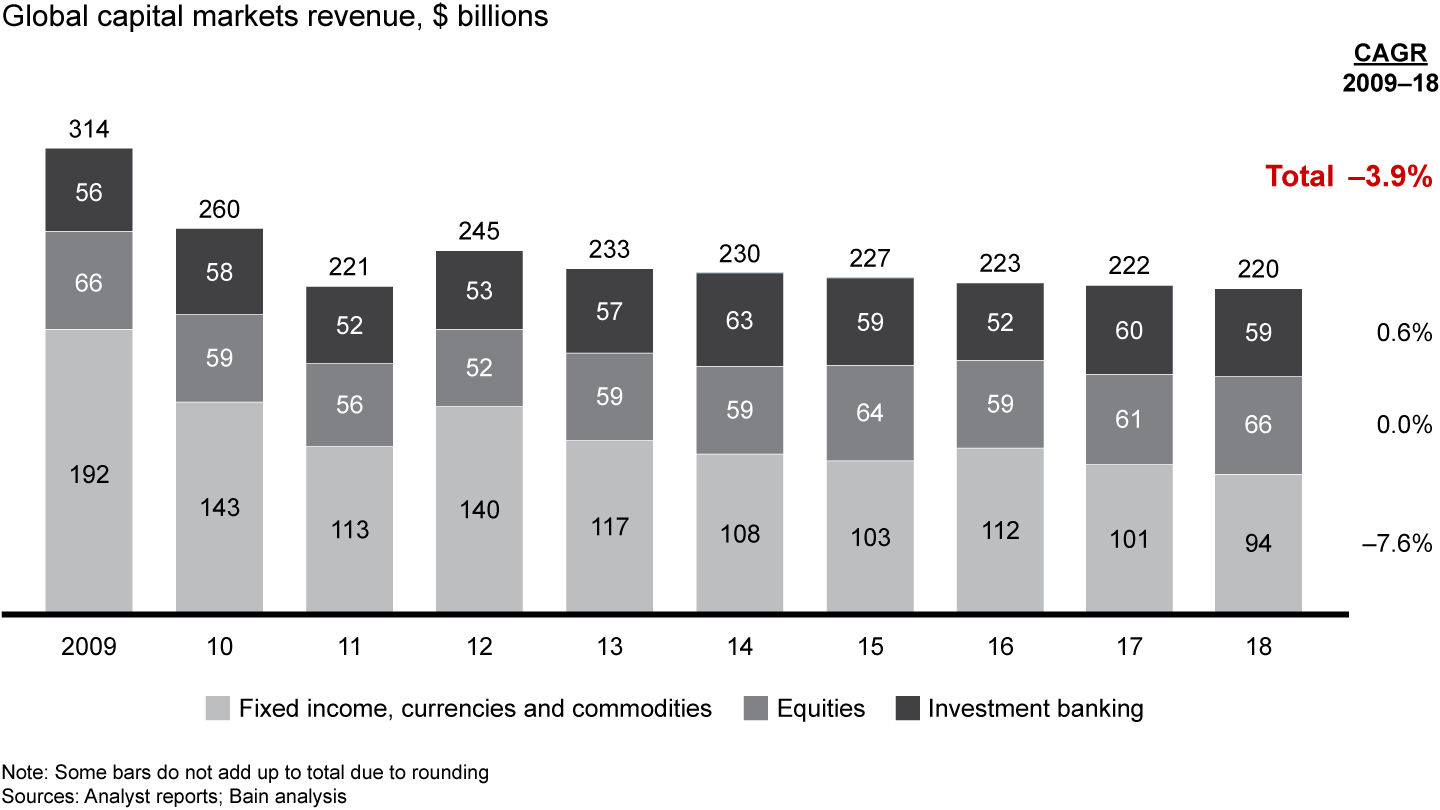

During that period, the total profit pool of the global capital markets business bounced around, dropping to $72 billion in 2018, from $74 billion a year earlier (see Figure 3). In addition, the average return on equity of the global capital markets business remained flat at approximately 10% in 2018.
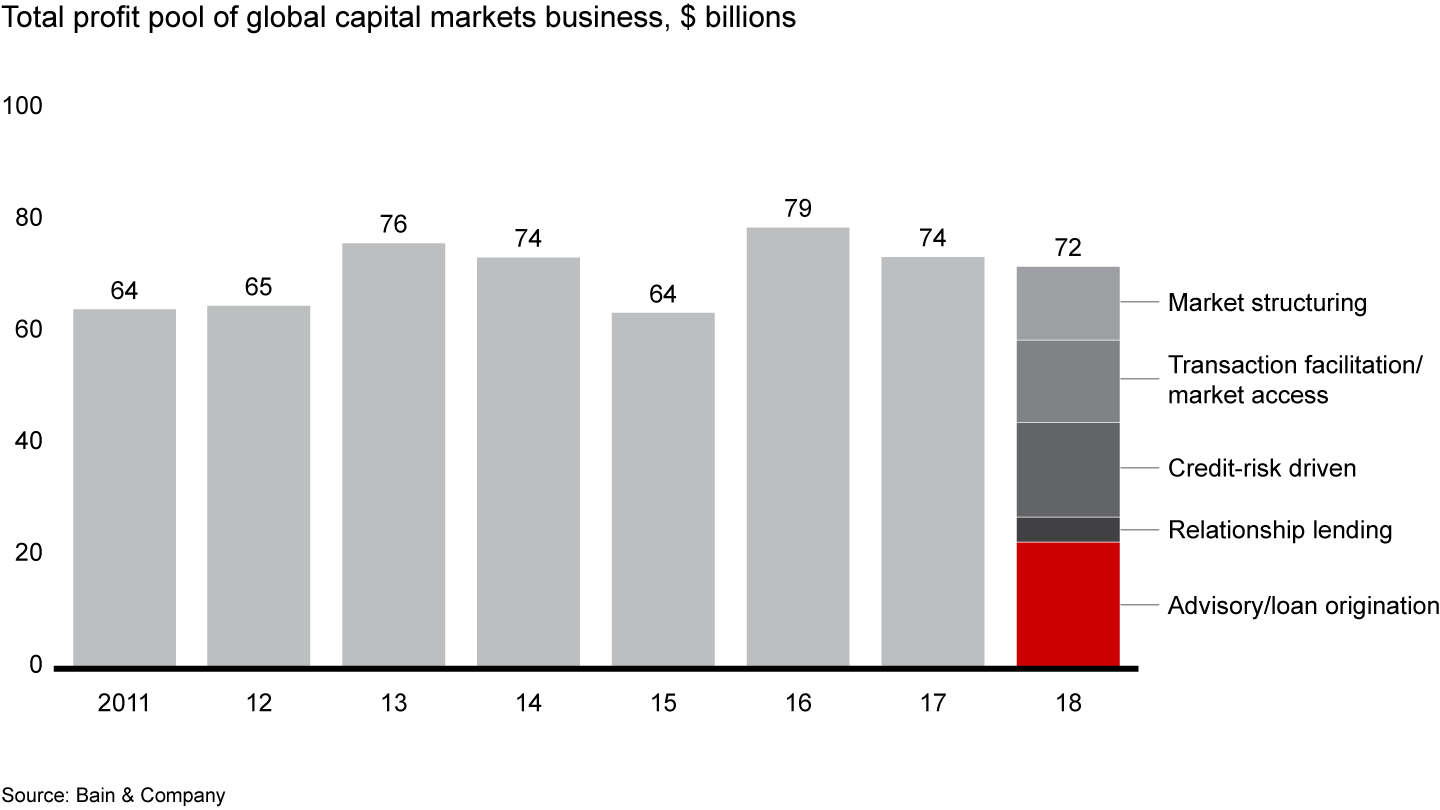

What can banks expect over the next few years? At a macro level, Bain & Company forecasts a base-case scenario in which global revenues will grow by 5%, or $11 billion, to $231 billion by the end of 2021. The fixed-income and M&A businesses would lead that growth. The base case could range from a high-case scenario of 10% growth, or $22 billion, to a low case of a 7% decline, or negative $16 billion, depending on how macroeconomic factors, technological advances and regulation play out (see Figures 4 and 5).
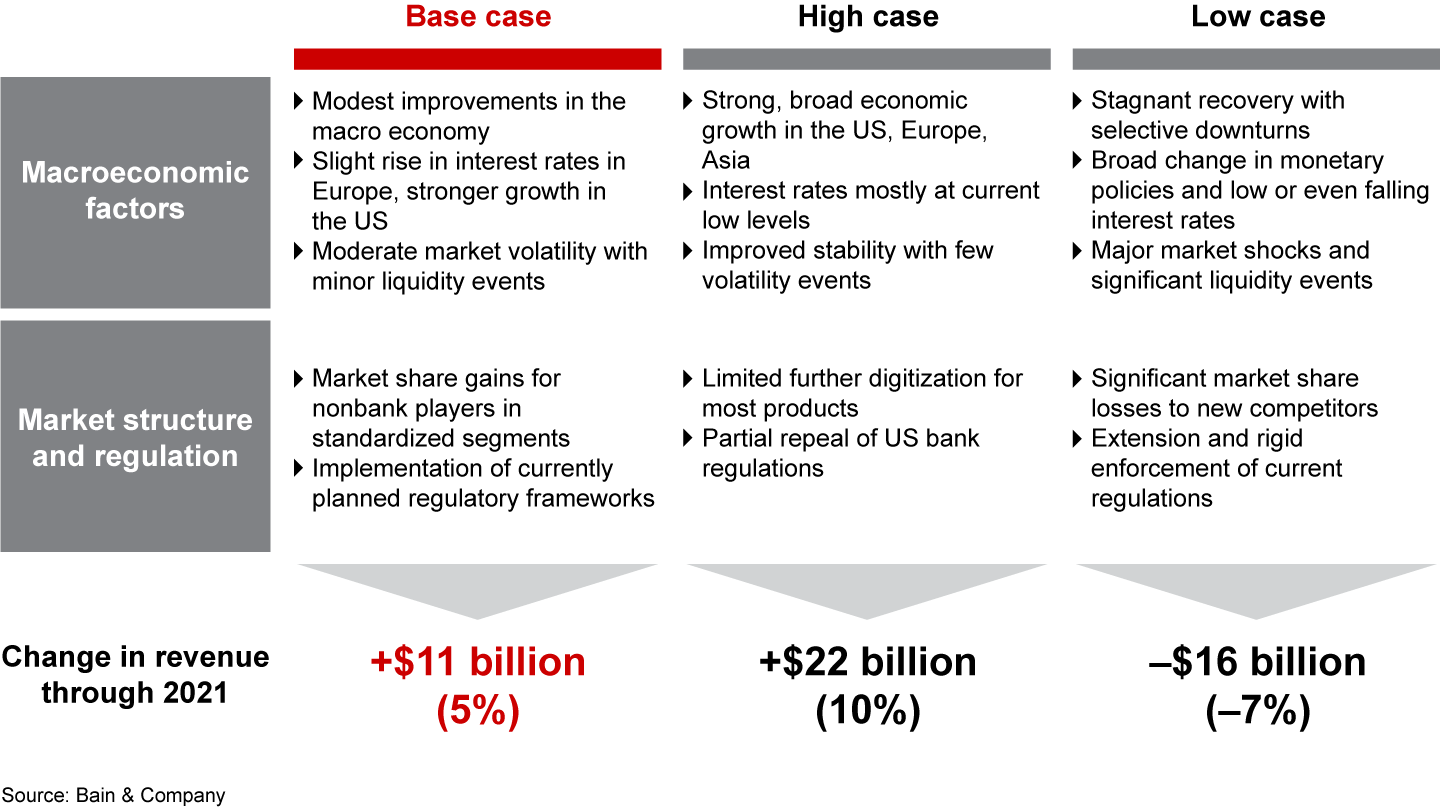

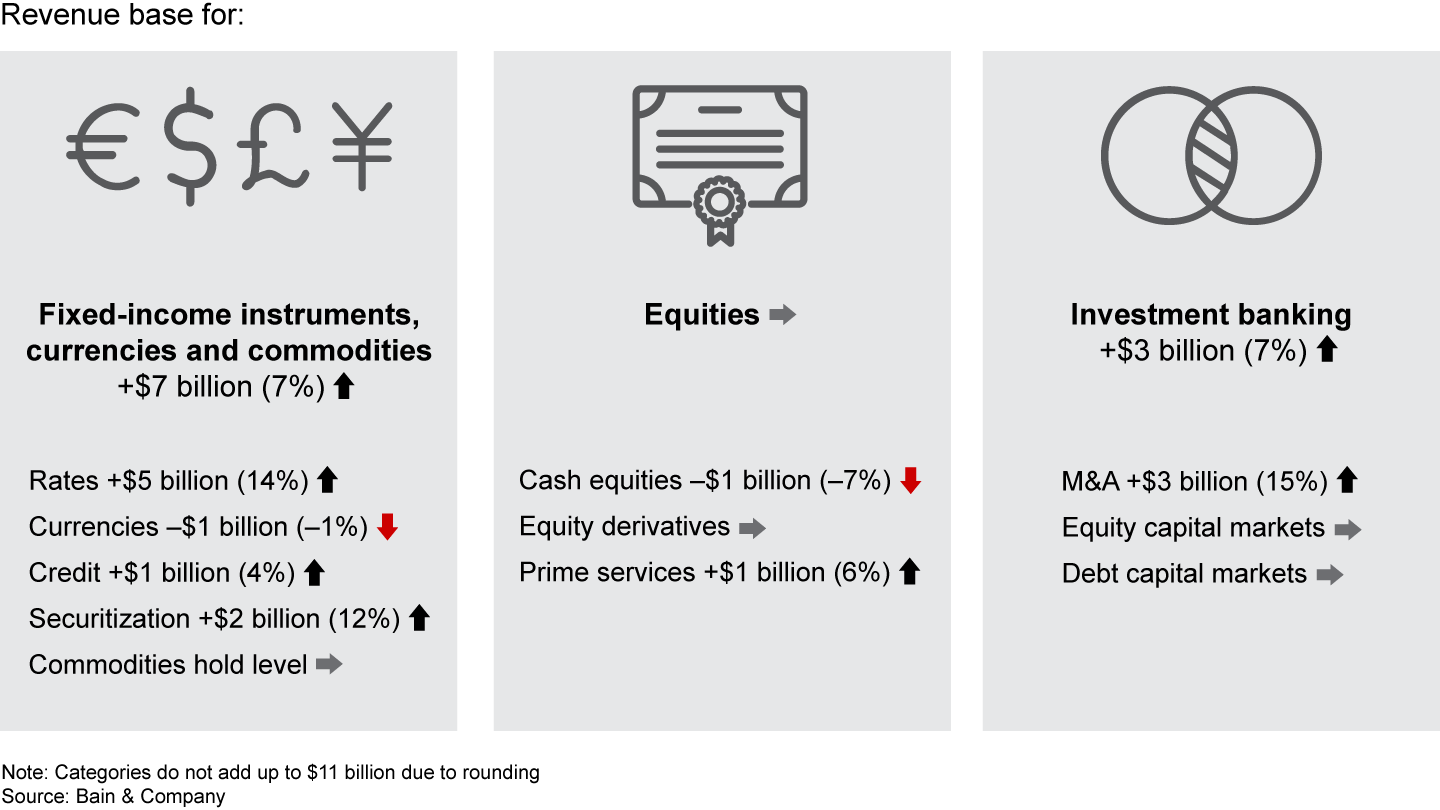

Capital markets encompasses a sprawling group of businesses, with different capabilities required to succeed in each. However, success overall boils down to four major imperatives, and the banks that have recently gained share consistently focus on these four areas.
1. Accelerate select investments in digital technologies
All capital markets competitors have been stepping up technology purchases and upgrades, to wring efficiency from operations, develop new services or raise service quality. Categories of technology vary greatly in their expected impact in the years ahead. Financial services executives expect machine learning, AI and blockchain to have the greatest impact by 2025, according to a Cognizant survey. Looking across the lines of business, Bain expects robotic process automation, digitization and blockchain to produce the largest effects in credit, commodities and rates (trading of sovereign bonds, derivatives, options on swaps and other products).
Some of these technologies are proving useful not only to reduce costs but also to limit risk. Goldman Sachs, an early innovator in banking technology, developed an interface called Deal Link to automate the initial public offering process. The technology eliminates informal checklists managed by young bankers, recurring legal and compliance phone calls, and other manual steps. So far, Goldman has automated half of the 127 IPO process steps, and the algorithmic screening can be far more accurate than screening by analysts.
Market digitization has become particularly relevant due to its anticipated dampening of revenue in areas such as credit and cash equities. Highly standardized and liquid products will come under the most severe pressure from digitization and new entrants.
Data analytics and AI, meanwhile, have become highly effective tools with which to gain a competitive long-term advantage in the market. At many large banks, it can still take a week just to learn which units and people interact with a major client, and which products and services are driving the majority of a bank’s risk-adjusted return on capital with the client. That’s why more and more banks are working to develop group-wide data strategies and digital tools that provide a single, easily accessed “source of truth,” allowing for full transparency into the bank’s internal-client activity and true profitability.
Before deciding where to invest in technological innovation, however, it pays to step back and take a holistic view. Review the entire value chain to determine, for example, which highly standardized, high-volume tasks represent early candidates for automation. These could be tasks in the know-your-customer process, compliance reporting or document collection. Other uses for digital tools involve enhancing employee performance, such as with AI-based pitch preparation, or tapping data analytics to swiftly build the case for or against a possible deal.
2. Upgrade the talent model
The evolution of capital markets requires rethinking the role of bankers for tomorrow’s environment. They will need to be more adept at using technology and leveraging data-driven insights, and professionals with those skills are hotly pursued by many industries. As the appeal of investment banking has dwindled, junior candidates have increasingly chosen careers with promising fintechs, major technology firms or even nonfinancial corporations.
At the VP and senior management levels, more chunks of work will be automated, putting a premium on interpreting AI and analytics. Executives can then use the freed-up hours to execute or sell business by spending more time with the most valuable clients.
The demand for soft skills, though, will not fade. When Bain interviewed executives at banks’ client companies, they consistently cited relationship management as the most dominant factor in recommending their “core bank.” In this context, they put the highest value on responsiveness, a proactive approach and stability of the bank’s coverage. To excel in relationships, banks will need to invest in frontline talent, mobilize the right sector and product specialists in the right place at the right time, and embed the client’s perspective into the chosen strategy. Winning banks, in sum, will be those that offer the most attractive talent model and performance culture.
Some US banks have taken innovative steps in this direction. At JPMorgan Chase, for instance, hundreds of new investment bankers and asset managers are required to take software-coding courses. This is one of many moves consistent with JPMorgan’s intention to be a technology group instead of a bank. It now spends more than $10 billion per year on technology, and technologists account for one-fifth of the firm’s workforce.
3. Raise the game in sales and marketing
More effective cross- and upselling comes from articulating a clear ambition, laying out a detailed account-by-account plan, and aligning compensation and other incentives. In contrast to some banks, where managers of different products still operate in silos, Goldman Sachs and some other major firms have fashioned incentive systems that encourage cross- and upselling. Both from a strategic and economic perspective, effectively cross-selling in the capital markets business matters today more than ever. If a bank serving corporate clients, for instance, cannot compete with its capital markets products on a standalone basis, its core products will suffer. As frequently seen among market incumbents, a trade finance solution for a corporate client becomes meaningfully more profitable through a well-structured and -priced capital markets product, such as a foreign currency hedge.
The question, however, is how to provide sufficient structure and incentives in the sales process to establish such a combined product solution as a standardized approach. Many banks have not yet reached their full potential on this dimension, mainly because they have yet to adopt a product-agnostic and solution-oriented mindset for their most relevant clients. Rather than simply responding to RFPs, banks with advanced commercial instincts identify clients with the greatest potential for ongoing, profitable business. European banks, in particular, have an opportunity to look beyond the largest clients to find attractive midsize clients. That franchise holds large potential value, as midsize companies still want close geographic proximity to their bankers—a preference that favors European, not US, banks.
Banks that strategically pursue commercial excellence are focused on developing their coverage function, which involves questioning the existing customer experience. As client demands grow more complex, an integrated coverage function allows the sales staff to provide tailored solutions. In an ideal world, this coverage function would be fully product-agnostic rather than specific to a distinct business division.
Strong sales and marketing also involves raising the metabolism of the organization, and the quality of execution, through crystal-clear processes and governance, which promote faster decision making. Here again, US banks often set the bar, in some cases taking less than a day to clear an urgent bridge loan. In contrast, some European banks take two weeks because of more complex governance structures and vaguely defined escalation procedures for such requests.
4. Look outside to the broader ecosystem
Examining the entire capital markets value chain may uncover opportunities for cultivating external partnerships with fintechs, market infrastructure players and nonbank participants (such as Citadel, DRW and Jump Trading) to upgrade a capability or fashion a better product. Keeping options open is key, so it’s worth considering a reasonably large number of potential partners. That requires a governance function to monitor which units are partnering with which companies, and which fintechs hold promise for a bank’s needs and goals. In light of growing competition—increasingly from nonbank players, including high-frequency-trading market makers and multidealer platforms—a bank’s ability to build and cultivate such external partnerships could be a critical success factor in the years to come.
Optionality comes from engaging with partners early on in loose interactions. When a partnership produces good results, the bank can consider taking a stake, bringing the partner’s employees in-house or making an outright acquisition. Following through at each stage, and monitoring and managing the ecosystem, will take dedicated resources, which European banks will have to start setting aside. It is also key to understand the cultural challenge and the mindset shift that will be required over time—that is, to regard fintechs not as competitors but as potential partners that could help a bank to become more agile and innovate.
Finding a purpose
Taking a purpose view helps banks map out an effective path on each of these imperatives (see Figure 6). A bank focused mainly on advisory services, loan origination and relationship lending will address the imperatives differently than an institution that competes more in the field of market access. Their different revenue pools have different underlying drivers and therefore different strategic needs. Applying a purpose view also helps banks avoid a nonintegrated, piece-by-piece optimization of certain parts of their businesses. Instead, it allows them to build the basis for a consistent multiyear transformation. (See the sidebar, “Too many change-the-bank projects? Time for a baselining exercise.”)
-
Too many change-the-bank projects? Time for a baselining exercise (click to expand)
In light of a large number of change-the-bank (CtB) projects already running and limited CtB budgets, not all banks will be able to map out an effective path on each of the imperatives and immediately start working on them. Instead, they should consider a baselining exercise to review all current projects and internal activities, with the objective of reallocating resources to the most value-enhancing areas.
To raise the odds of success in a CtB project, most banks will want to take control of their IT by bringing resources back inside the bank. This effort should not focus on the number of employees but rather on better aligning employee skills with new technologies. Having a purpose view to map out the path for each imperative will help banks make the right decisions to define their future and better allocate resources.
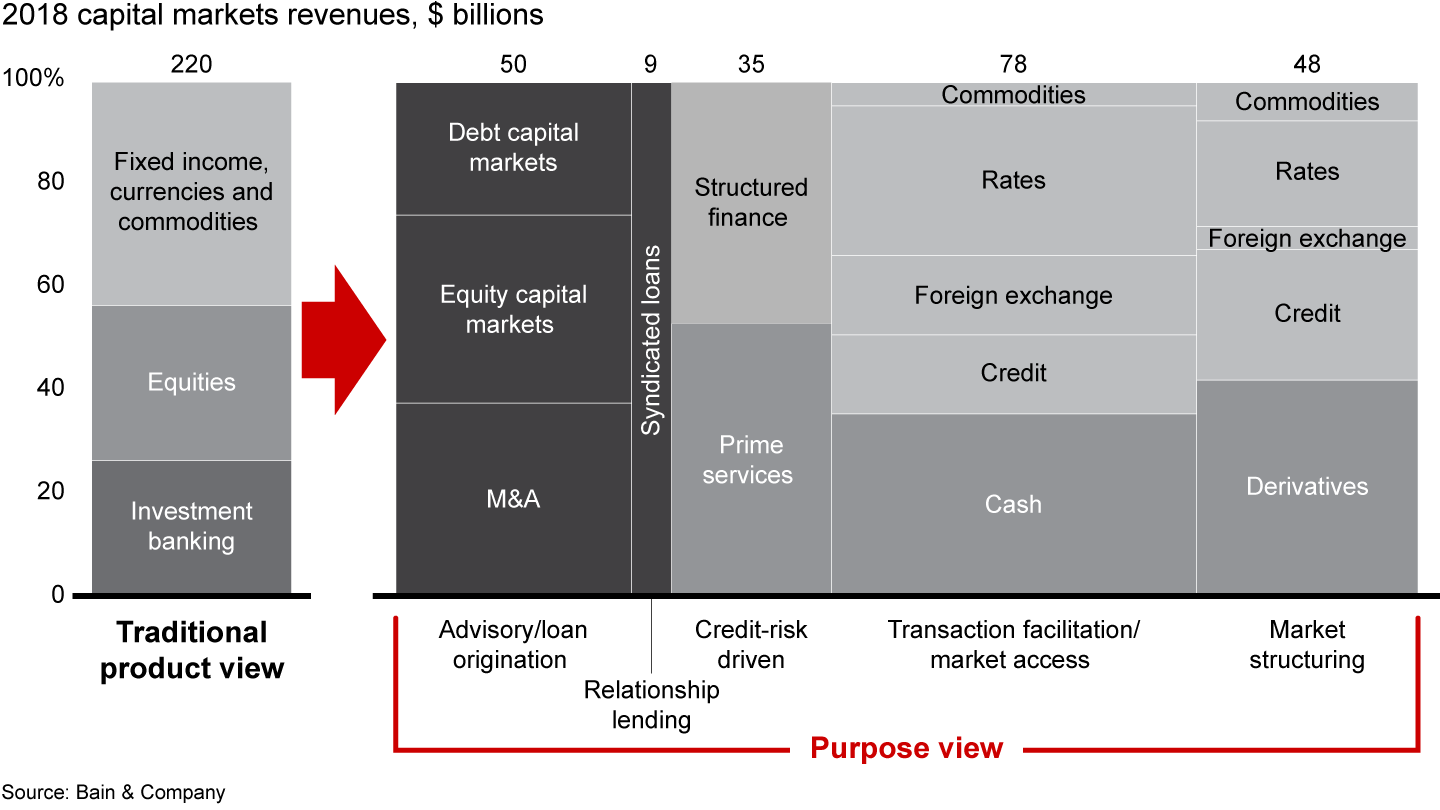

Consider, for instance, a private bank based in France that emphasizes advisory services and deal origination. Gaining share will require solid account coverage in the countries where it plans to expand. It will have to determine which industry sectors hold the greatest potential, and balance local industry expertise with the cost of planting specialists in each country. The bank will need to recruit talent in equity capital markets and M&A, with skills in relationship building, to advance the business.
By contrast, companies that provide market access as one of their core offerings, such as BNP Paribas and Credit Suisse, depend more on scalable, efficient operations using state-of-the-art IT platforms. Providing the fastest, cheapest trades involves highly efficient execution, strong client interfaces and continued investment in technology.
To be sure, a bank’s selected purpose should flow from its core capabilities. When considering one or two adjacent products through which to increase scale and profitability, bankers should assess not only the attractiveness of the opportunity but also their ability to compete over the long run. Only a rigorous review of a bank’s strengths from a strategy perspective can unlock the right moves and avoid the gradual buildup of a complex, slow and inflexible operating model.
Mike Kühnel, Christian Graf and Thomas Olsen are partners, and Didier Valet is a senior advisor, with Bain & Company’s Financial Services practice. They are based, respectively, in Frankfurt, Munich, Singapore and Paris.